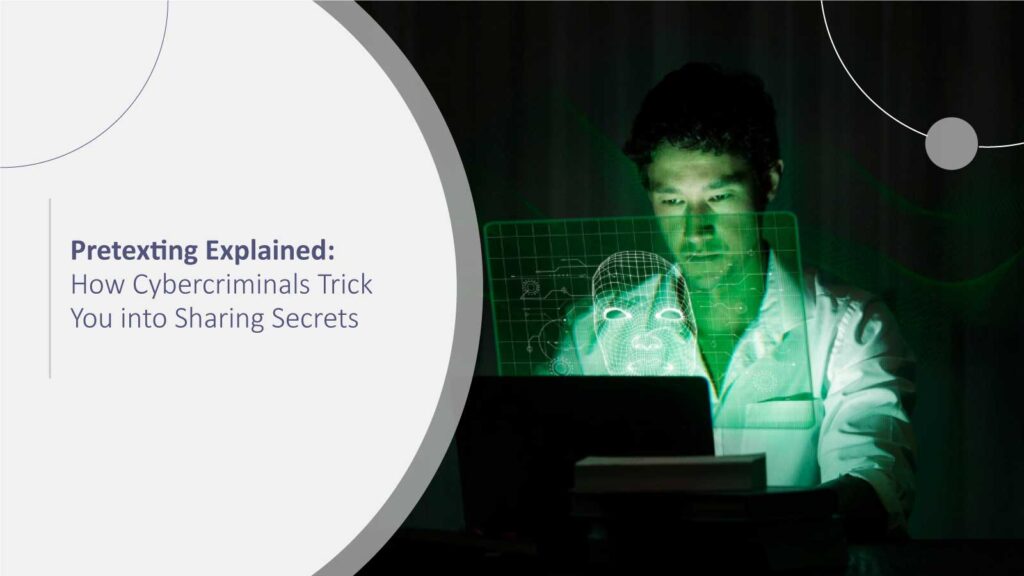Introduction: The Oldest Scam in the Cyber Book
As you sit at your desk, the phone rings. You answer, and a polite person on the line introduces himself as an “IT security expert from the headquarters of your organization”. The caller sounds legitimate, knows who you are, and casually mentions the new software rollout that your department heard about the week before. What you may not realize is this is a great example of pretexting. Pretexting is just one method of social engineering where the attackers creates believable situations to manipulate you into divulging sensitive information.
And then the hook: “I just need your login to check that your account access is functioning properly.” Innocent-sounding, right? Nope. That’s pretexting of the oldest, yet still one of the strongest, forms of cyber deception.
Whereas ransomware and zero-day exploits typically shout loudly throughout the headlines, actually, it is the less obvious, more targeted attacks like pretexting that prevail most often. From Verizon’s 2024 Data Breach Investigations Report, nearly 74% of breaches involve some form of human component, like manipulation techniques like pretexting. In this article, we’ll explain what pretexting is, why it’s so dangerous for today’s professionals, how cybercriminals execute it step by step, and most significantly, how you can defend yourself and your business.
What Exactly Is Pretexting?
Pretexting is a manipulation tactic in cybercrime where the attacker fabricates a convincing scenario to mislead a person into releasing confidential details. Unlike phishing, which usually casts a wide net with mass emails, pretexting is targeted, calculated, and interactive.
Here’s the anatomy of a pretexting scam:
- The Script: A convincing backstory (e.g., “I’m from the finance team, confirming your vendor payment details.”).
- The Pretext: Implied or borrowed authority (i.e., pretending to be a manager, IT staff, or vendor).
- The Objective: Pilfering data, credentials, or even money.
Think of it as cyberthieves staging a play. All the “stage” is your email inbox or phone line, and the “spectators” are you.
Why Pretexting Beats What You Think
Overworked professionals are the most typical pretexting targets. Why? Because speed and trust dominate work today. When your email inbox contains 147 unread emails and your calendar is booked solid, spending time verifying a request seems like an extravagance.
Here’s why pretexting poses such a risk for today’s workforce:
It draws on authority bias. People naturally trust authority figures. A request from the “CFO” carries weight.
It takes advantage of urgency. Threat actors include artificial time pressures, “approving this transfer within 30 minutes” to force instant decisions.
It takes advantage of overload. In a digital-first world, information overload disables our defenses.
A McKinsey report on cyber resilience had established that over 60% of executives admit their organizations are not well prepared to deal with sophisticated social engineering attacks.
Therefore, while firewalls and endpoint detection headline the news, the weakest link remains all too frequently human trust.
How Pretexting Works: The Step-by-Step Playbook
Let’s take a closer look at the typical play-by-play of a pretexting attack to better understand how cybercriminals get the upper hand.
1. Research: Constructing the Background
Attackers gather information from public domains, company websites, press releases, LinkedIn, and social media. They may find out who occupies a finance title, your suppliers, and even company events happening.
2. Pretexting
Using this data, they construct a pretext:
- Fake IT needing “system checks.”
- Role-playing as HR requesting tax information.
- Role-playing as a supplier giving payment updates.
3. Establishing Credibility
The scammers can fake caller IDs, copy email domains, or insert company jargon. The goal is to dispel doubt.
4. The Ask
After gaining trust, they make their request for credentials, wire transfers, and employee files. The ask typically comprises the promise of impending doom: “We must have this immediately to avoid penalties.”
5. Exploitation
The information is used for fraud, identity theft, or to compromise systems. At times, a successful pretexting attack is an entrée to larger breaches.
Examples of Pretexting in Real Life
1. The CEO Voice Scam
Criminals leveraged AI-voice deepfakes in 2022 to mimic the voice of a European firm’s CEO. An employee, believing they were complying with urgent orders, authorized a transfer of $243,000. (Forbes Tech Council)
2. Vendor Payment Redirection
BEC (Business Email Compromise) often uses pretexting. Fraudsters pose as suppliers and send updated banking details. According to the FBI’s Internet Crime Report, BEC schemes cost U.S. businesses over $2.7 billion annually.
3. Spoofed IT Support Calls
Threat actors posing as IT staff call employees and ask for passwords “to fix access issues.” IBM’s Cost of a Data Breach 2024 shows social engineering attacks are worth $4.45 million on average per breach.
Such situations reflect a somber reality: pretexting steals not just information, it siphons trust, reputation, and capital.
Why Pretexting Works
Pretexting is based more on human psychology than technology. It works because:
- We bow to authority. Few employees question an overt executive.
- We fear not complying. No one wants to be the reason a deal falls through.
- We want to be helpful. Attackers capitalize on the human need to help.
- We rush. Rushing narrows judgment and diminishes skepticism.
Ever read an email quickly just to “get it off your plate”? Pretexting thrives on that millisecond decision.
How Professionals Can Protect Against Pretexting
Here’s the good news: while pretexting is powerful, it’s also preventable.
1. Verify Before You Disclose
Always check out dubious requests through another channel. When “HR” requests tax data via email, HR directly.
2. Normalize Request Procedures
Implement standard procedures for sensitive functions, such as requiring two approvals for financial transactions.
3. Build Security Awareness
Regular training through simulated pretexting attempts keeps staff alert. Social engineering threats are also found to be decreased by up to 70% through awareness programs, as indicated by Gartner studies.
4. Enforce Zero Trust
Zero Trust security assumes that no one is trusted in the first place, even inside the organization. Combine this with layered login verification to contain the fallout.
5. Involve Employees
Promote a culture in which workers are motivated to ask suspicious requests without fear of “being difficult.”
The Future of Pretexting: AI, Deepfakes, and Automation
The advent of generative AI has sped up pretexting. Attackers now use:
- AI voice cloning to pretend to be company executives.
- AI-written emails that can imitate writing styles.
- Chatbots to chat with victims in real-time.
Research warned that AI-powered social engineering attacks could increase in magnitude and capability in the next three years.
The takeaway? Pretexting is no longer a call; it’s evolving into a high-tech scam that involves psychology coupled with cutting-edge AI.
Conclusion: Don’t Let the Storyline Fool You
Pretexting isn’t a hack; it’s a script. Computer criminals succeed with it not because they’re great programmers, but because they’re good storytellers who know how to leverage human psychology to their benefit.
Here’s the empowering truth: if you can see the playbook, you can tell them to take a hike somewhere else.
Take it slow.
Check everything.
Keep this in mind: urgency is often the worst enemy of accuracy.
Security is not paranoia, it’s professionalism. The next time someone’s nice voice can be heard saying, “Just a quick confirmation,” take a moment to think: Am I speaking with a co-worker or a scammer with a script?
FAQs
1. How is pretexting different from phishing?
Pretexting involves the creation of a deep, interactive history to fool victims, while phishing exploits bulk emails or diabolical links targeting broad audiences.
2. Which industries are the most susceptible to pretexting attacks?
Finance, healthcare, and professional services are most susceptible since they have sensitive financial and personal data, and employees work within time constraints.
3. Can AI increase the difficulty of detecting pretexting?
Yes. AI voice cloning, deepfakes, and AI-assisted emails make it easier for attackers to pass themselves off convincingly as trusted sources.
4. How do businesses instruct workers to recognize pretexting?
Simulation attack practice, scenario training, and regular awareness sessions force employees to stop, question, and confirm.
5. Is pretexting illegal?
Yes. In the United States, pretexting is addressed under fraud and identity theft laws, with severe punishments, including fines and imprisonment.
For deeper insights on agentic AI governance, identity controls, and real‑world breach data, visit Cyber Tech Insights.
To participate in upcoming interviews, please reach out to our CyberTech Media Room at sudipto@intentamplify.com.







